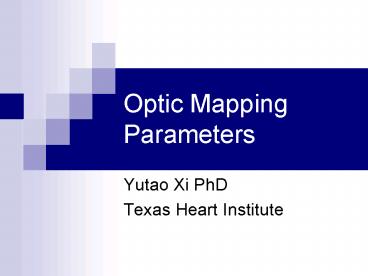Optic Mapping Parameters PowerPoint PPT Presentation
1 / 32
Title: Optic Mapping Parameters
1
Optic Mapping Parameters
- Yutao Xi PhD
- Texas Heart Institute
2
Outline
Heterogeneity
S1-S2 program pacing
Baseline pacing
Fibrillation /Tachycardia
Movement artifices
20049521-33 Circ. Res.
3
Analysis of optical action potential
4
Action potential duration
97 recovery of the AP
- Advantages
- the detection of (d2F/dt2)max can be computer
automated - it detects repolarization time points reliably
- it is possible to simultaneously map
repolarization and refractoriness
5
Action potential duration
fluorescence signal (light trace)
phase of a site (bold trace)
J Cardiovasc Electrophysiol,Vol. 13, pp.
1141-1149, 2002)
6
Color map of APD 20 and 80
J Cardiovasc Electrophysiol, 14, 739, 2003
7
Optical APs from mice with LQT
E
B. London and others J Physiol 578.1
8
APD versus cycle length
9
Reporlarization restitution
- Reporlarization restitution (adaptation of action
potential duration to heart rate). - Defined as the relationship of APD to its
preceding diastolic intercals (DI) over a rang of
cycle lengths. - The APD is measured after an extrastimulus given
at a progressively shorter coupling interval (S2)
after a basic train of stimuli (S1).
10
Repolarization restitution
Rk (restitution kinetics ) rate constant of
restitution OR Slope of curve at the high rate
pacing
Circulation Research. 199679493-503
11
Repolarization restitution
APDb longest
APDb shortest
12
Action potential restitution
cycle length
cycle length
Rk
gt1 would be arrhythmogenic lt1 would dampen action
potential alternans
Rk
Circulation 99, 28192836.
13
Spatial dispersion of restitution kinetic (Rk)
The effect of propagation direction on Rk and
Time constants of Restitution (T).
14
Map of local velocity vectors(Local conduction
velocity)
15
How a velocity vector is calculated for the pixel
least-squares fit method
The increasing fastest represents the direction
The maximal slope represents the inverse of the
speed of conduction
J Cardiovasc Electrophysiol. Vol. 10. pp.
1361-1375, 1999)
16
Maps of activation and local velocity vectors
.
.
.
.
.
.
Qi,j (m/s)Activation time delays /interdiode
distance
orientation of Qi,j reciprocal absolute value of
Qi,j
.
.
.
News Physiol. Sci. Volume 15 February 2000
17
V?x/?t
18
Isochronal map and its corresponding vector field
19
Effects of tetrodotoxin (TTX) on local conduction
velocity (CV)
Control
Washout
TTX
CVmax
CVmin
20
Epicardial ventricular conduction velocities from
WT and Cx40-/- knock out mice heart
21
Cycle length dependence of local conduction
velocity (CV) in transgenic mice
22
Frequency distribution and spatial organization
of Fibrillation/Tachycardia
23
Spectral analysis of optical traces in VF
Circ Res. 200291339-
24
Fast Fourier transform (FFT) to analyse the
dominant frequencies of VT
B. London and others J Physiol 578.1
25
Blueprints
AP, APD,APD /MAP
Activation time /Map
Basic pacing (fixed CL)
Repolarization time /Map
Local conduction velocity /Map
S1-S2 pacing
Restitution of APD,
Frequency distribution spatial organization
VT/VF induced
26
Raw DATA
S1-S1
Optical
ECG
Optical
S1-S2
S1
S2
ECG
S2
S1
27
Motion artificial effect
- Mechanical support
- Chemicals uncouple
- Post acquisition analysis
- Dual-wavelength optical mapping system
28
Effects of DAM and cyto-D on restitution kinetics
and conduction velocity
AJP-Heart Circ Physiol VOL 287 OCTOBER 2004
29
Effects of DAM and cyto-D On APD
During acquisition
control
diacetyl monoxme (DAM)
cytochalasin D (cyto-D)
AJP-Heart Circ Physiol VOL 287 OCTOBER 2004
30
Post acquisition analysis
31
During acquisition
- 1 Conf Proc IEEE Eng Med Biol Soc.
200453578-80. Links - High resolution optical mapping of cardiac action
potentials in freely beating rabbit hearts. - Inagaki M, Hidaka I, Aiba T, Tatewaki T, Sunagawa
K, Sugimachi M. - Department of Cardiovascular Dynamics, National
Cardiovascular Center Research Institute, Suita,
Japan. - Optical mapping of action potentials (APs) has
become important tools for the cardiac
electrophysiology. However, cardiac contraction
unavoidably produces motion artifacts (MA) in
optical signal. We developed a method to suppress
motion artifacts without arresting the hearts.
METHODS Using a dual-wavelength optical mapping
system, APs were recorded on the surface of an
isolated rabbit heart. Transmembrane APs were
simultaneously recorded using glass
microelectrodes. We eliminated MA in a frontal
plane by a motion tracking technique.
Subsequently, a dual-wavelength ratiometric
method was used to remove MA in a vertical
direction to a frontal plane. RESULTS MA were
effectively removed from optical signals. Action
potential duration measured from optical signals
corresponded with those measured from
microelectrodes (r20.9677). Our method enables
us to map action potentials in freely beating
hearts. - PMID 17271064 PubMed
32
Thanks!

